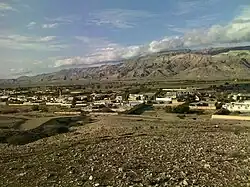Bigherd
Bigherd (Persian: بيغرد, also Romanized as Bīgherd; also known as Bokherd and Bīqerd)[3] is a town in Tang-e Narak Rural District of the Central District of Khonj County, Fars province, Iran.
Bigherd
Persian: بيغرد | |
|---|---|
town | |
 | |
 Bigherd | |
| Coordinates: 27°51′16″N 53°36′58″E[1] | |
| Country | |
| Province | Fars |
| County | Khonj |
| District | Central |
| Rural District | Tang-e Narak |
| Population (2016)[2] | |
| • Total | 2,593 |
| Time zone | UTC+3:30 (IRST) |
The town is located 15 km from Khonj. Its exports are dates and watermelons. The watermelons from bigherd are considered the best type of watermelons in the region.
The name Bigherd in the Avestani language means “The Khodadade region”, which historians believe is derived from a river called Bigh-rood that existed in the 14th century, bigh-rood means “beside the river” in Persian The climate of this area is hot and dry. This village is known as the jewel of Larestan because of its rapid and sudden development and having countless benefactors. Bigherd has more than 800 residential houses and a population of more than 3854 people. Bigherd is the center of Tang e Narak district. The people of bigherd speak the achomi language and the religion of the bigherdi people is Sunni Shafi'i Islam. The ancient and natural areas of bigherd include Tokh Castle; Shahneshin Castle; Tange Narak Spring; Tomb of Pirjafti; Tomb of Seyyed Makram. The town has made significant progress since 2010 at the hands of Bigherd’s benefactors.it also had two old schools in the 70s and now it has a kindergarten and six schools for boys and girls, and its new schools were established in the 90s and the 2000’s
History
Bigherd, has a rich 700 year history, The population in Bigherd is originally descended from Khonj, moving into Bigherd in the 14th century, some other people from kariyan moved into bigherd after the 1914 famine in iran, they are called the “karyuni” people in the local language, meaning they came from kariyan
Many of the Bigherd population have moved to GCC countries as early as the 1950s as expats. Bigherd is also a common place for earthquakes, with one on 18 November 1998. Five people were killed as a result of the earthquake, and 80 injured. Between 50-100% of the houses in Bigherd village sustained some significant degree of damage.
A second earthquake measuring 4.8 on the Richter scale occurred at 22:00 local time on the same day. Roads to the area reportedly remain blocked due to landslides, making access to gather information and to transport possible casualties impossible.
Kal’e Tokh Palace (Tokh Castle), was completely destroyed due to the great Bigherd earthquake, it belonged to Ahmad Tokh.
Ahmad Tokh was the chief of Bigherd. He was a Prince at the time of El-Kia, and was exiled to the south of the country (bigherd) after the fall of the government. His palace was destroyed by cannons during the Qajar rule
References
- OpenStreetMap contributors (23 September 2023). "Bigherd, Khonj County" (Map). OpenStreetMap. Retrieved 23 September 2023.
- "Census of the Islamic Republic of Iran, 1395 (2016)". AMAR (in Persian). The Statistical Center of Iran. p. 07. Archived from the original (Excel) on 6 April 2022. Retrieved 19 December 2022.
- Bigherd can be found at GEOnet Names Server, at this link, by opening the Advanced Search box, entering "-3056381" in the "Unique Feature Id" form, and clicking on "Search Database".
